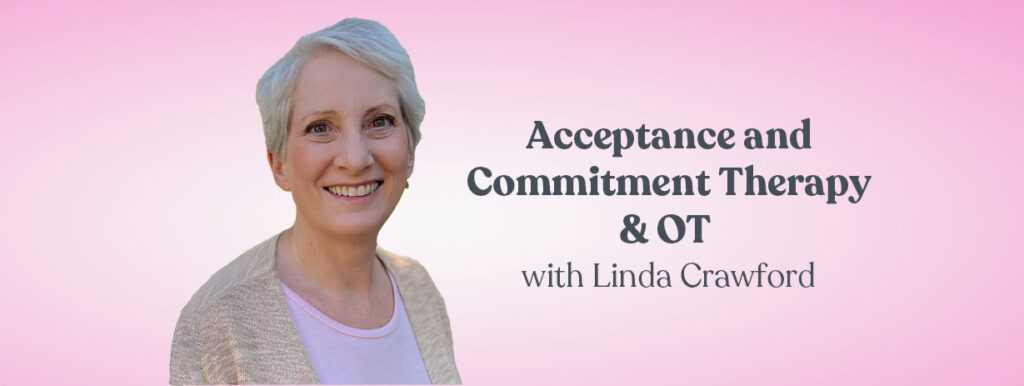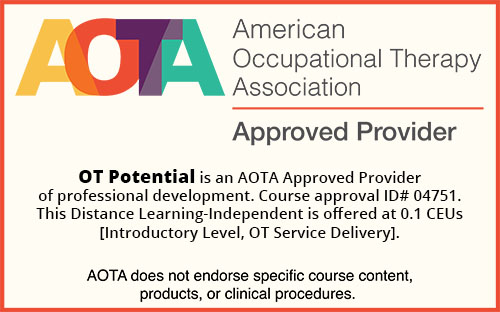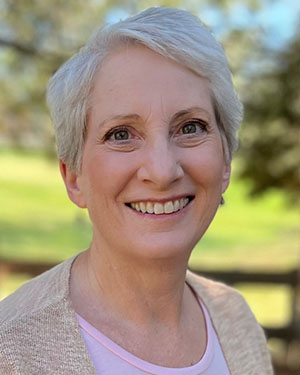Acceptance and Commitment Therapy Continuing Ed for Occupational Therapist Ed
Earn 1 hour of continuing education by joining the OT Potential Club after listening to this OT Potential Podcast course on Acceptance and Commitment Therapy (ACT), Chronic Pain, and OT.

Acceptance and Commitment Therapy (ACT) weaves together multiple concepts that OTs are already familiar with and often use in practice. On a personal level, it provides helpful tools we can utilize as we navigate complex situations in our work.
But, not only is it personally helpful, the research we're looking at today shows us why we need to be aware of it as a therapy professional:
Research supports the use of ACT in addressing chronic pain.
In the research study we'll explore in this podcast episode, you'll find that OTs were part of an interdisciplinary team that provided intensive pain management treatment built around ACT. (And, that the program led to positive functional outcomes.)
To help us unpack how this information can be integrated into your practice, it is our honor to bring on Linda Crawford, OTR/L, CDWF. Linda has been an occupational therapist for over 30 years and has specialized in working with people with complex pain conditions for the last eight years. She is a contributing author to the newly updated AOTA position paper on the role of occupational therapy in pain management.
See all listening platforms for the OT Potential Podcast.
Primary Journal Article Explored
When you log in, be sure to check out the OT Potential Club's written breakdown of the following research article. Then, share your questions and thoughts with fellow practitioners.
Yu, L., Norton, S., & McCracken, L. M. (2017). Change in "Self-as-Context" ("Perspective-Taking") Occurs in Acceptance and Commitment Therapy for People With Chronic Pain and Is Associated With Improved Functioning. The journal of pain, 18(6), 664–672.
Pain, ACT, and OT Resources
- Self-Compassion Test by Kristen Neff
- AOTA Position Paper: The Role of Occupational Therapy in Pain Management, 2021. (Free access for AOTA members)
- Interoception Resources from Kelly Mahler
- International Association for the Study of Pain (IASP)
- Dr. Kevin Cuccaro pain science education video – Your Brain and Pain
- Association for Contextual Behavioral Science
- Springboard – group pain management training program based on ACT – Bronnie Lennox Thompson
- Brené Brown Daring Way™ website to find certified facilitators:
- Pain BC free webinar by Linda Crawford, OTR, CDWF: Do, Feel, Think: Humanizing the Pain Experience From an Occupational Therapy Perspective:
- PAINOT Facebook group
Pain Resources for OT Clients
- The Pain Toolkit
- Pain Chats
Supporting Research and Journal Articles
Kemani, M. K., Kanstrup, M., Jordan, A., Caes, L., &; Gauntlett-Gilbert, J. (2018). Evaluation of an intensive interdisciplinary pain treatment based on acceptance and commitment therapy for adolescents with chronic pain and their parents: A nonrandomized clinical trial. Journal of Pediatric Psychology, 43(9), 981–994.
Berglund, E., Anderzén, I., Andersén, Å., Carlsson, L., Gustavsson, C., Wallman, T., &; Lytsy, P. (2018). Multidisciplinary intervention and acceptance and commitment therapy for return-to-work and increased employability among patients with mental illness and/or chronic pain: A randomized controlled trial. International Journal of Environmental Research and Public Health, 15(11), 2424.
Learning Objectives
- You will be able to identify practical strategies for incorporating self-as-context into your treatments.
- You will recognize unique ways OT can leverage the principles of ACT during evaluations and treatments.
Agenda
Intro (5 minutes)
Breakdown and analysis of journal article (5 minutes)
- What is Acceptance and Commitment Therapy?
- ACT and Chronic Pain
- What was the intent of this paper?
- What were their methods?
- What were the results?
- Conclusions and discussion
- Takeaways for OT practitioners
Discussion on practical implications for OTs (with guest Linda Crawford) (50 minutes)
- Can you tell us about how you found OT?
- Would you be willing to share your personal experience with chronic pain?
- Can you tell us about Brave Therapy?
- Turning to the article, I want to start by asking you about "self-as context", what does this concept mean to you?
- Are there any concepts of ACT that you think are important for OTs to understand?
- OTs are often involved on interdisciplinary teams for ACT, what unique lens/skillset do you think we bring to this kind of treatment?
- I was interested in the assessment that they used—are there any other chronic pain assessments you think OTs should be aware of?
- You helped write the OT position paper on pain management—what are other big picture trends in OT and pain management you think our listeners should know about?
- What is your vision for OTs' role in pain management 5 years from now?
- What is one practical strategy that you hope OTs use with their patients after listening to this episode?
Contact Hours
1 hour (0.1 AOTA CEUs). Released online from Aurora, NE.

Target Audience/Educational Level
Our target audience is occupational therapy practitioners who are looking to learn about Chronic Pain, ACT, and OT. The educational level is introductory.
Instructional Methods/Registration/Special Needs Requests/Cancellation Policy
This course is an independent/self-study course delivered via podcast on iTunes, Spotify and Google Play. Explore your listening options on the OT Potential Podcast page.
If you need accommodations to take this course, please contact us and we will address your needs on an individual basis.
If this course were to be canceled, please see our cancellation policy on our terms page.
Course Completion Requirements
In order to receive a certificate for this course, you must first listen to the podcast in its entirety. Then, you will need to take the test (found at the top of this page) and earn 75% or higher. If you pass, a certificate will be automatically generated and sent to your email.
Financial and Non-financial Disclosures
It is the policy of OT Potential to disclose any financial and non-financial interest the provider or instructor may have in a product or service mentioned during an activity. This is to ensure that the audience is made aware of any bias of the speaker.
We here at OT Potential have no financial stake in this topic. Our guest, Linda Crawford, has her own local pain-management private practice in Colorado, but no financial stake related to a broader audience of OT practitioners.
Speakers
Linda Crawford, OTR/L, CDWF:

Linda has been an occupational therapist for over 30 years and has specialized in working with people with complex pain conditions for the last eight years using her 3-part framework: Restore Your Body, Rebuild Your Life, Renew Your Joy.
Linda is a Brené Brown Daring Way™ certified facilitator, a clinical advisor for the development of the Occupational Experience Profile tool, teaches courses for OT practitioners and multidisciplinary groups on best practices in pain rehabilitation, administrates the PAIN OT Facebook study group, and is a contributing author to the newly updated AOTA position paper on the role of occupational therapy in pain management. Linda is also a passionate advocate for the profession of occupational therapy and serves as the current president of The Occupational Therapy Association of Colorado.
Prior to specializing in pain care, Linda spent over ten years of her career specializing in brain injury and stroke rehabilitation. She has also been a complex seating and positioning specialist, and has worked in acute hospital, burn unit, acute and sub-acute rehabilitation, outpatient clinic, and home health settings.
Personal note: I am passionate about helping OT practitioners understand the value of their role in working with people in pain! I had a personal experience of four years of persistent pain and all the traditional therapy and medical treatments I was prescribed failed to improve my pain. It was then that I realized I had done everything except OT and that occupational therapy was not a job I performed, it was a core belief I had – that every person has the ability to influence their own health and well-being and live a meaningful life if provided with the support and skills to do so. I knew that if I "OT'd" myself my life and pain experience would be better. Since that time, I have relentlessly researched. Personally applied, and taught others about current pain science and therapy and the biopsychosocialspiritual (BPSS) factors that influence our health and well-being. I am thrilled to share that I am now eight years chronic pain free and am back to enjoying meaningful activities I was told I would never be able to do like running, hiking, and playing golf!
Sarah Lyon, OTR/L:

Sarah's passion is helping fellow OT practitioners translate evidence into daily practice. Sarah earned her BA in religion from St. Olaf College, then earned her master's degree in occupational therapy from New York University in 2011. Since then, she's worked in numerous facilities, including a critical access hospital, an acute trauma hospital, and a state inpatient psychiatric hospital.
Sarah is the founder/owner of OT Potential. Read more about OT Potential here.
This course was designed to meet your continuing education requirements
We designed the courses in the Club to meet the requirements for "online" and "independent/self-study" courses. For more details read our blog post: Can I earn OT CEUS from a podcast? To verify the requirements from your specific state (within the US), check out our post, OT Continuing Education Explained. If you are outside of the United States and have questions, please contact us.
We are proud to be an AOTA Approved Provider and to meet the requirements for your NBCOT renewal.
See our other OT courses!
Source: https://otpotential.com/ceu-podcast-courses/acceptance-commitment-therapy-ot
0 Response to "Acceptance and Commitment Therapy Continuing Ed for Occupational Therapist Ed"
Post a Comment